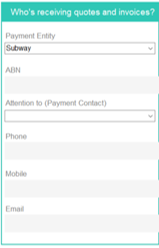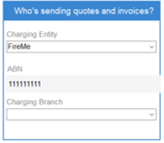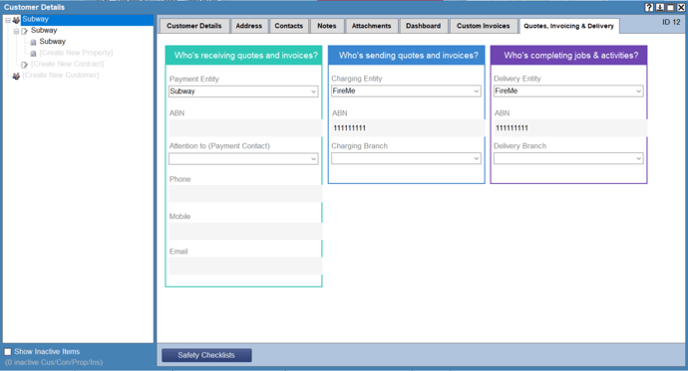Control your revenue allocation for FireMate activities with Payment, Charging and Delivery Entities!
Product: FireMate Desktop
Contents
-
What are Payment, Charging and Delivery Entities?
- When to use Payment, Charging and Delivery Entities
- Example of when to use Payment, Charging and Delivery Entities
What are Payment, Charging and Delivery Entities?
When viewing a Customer, Contract, Property or Service Request in FireMate, you will see reference to a tab called “Quotes, Invoicing & Delivery”.
Where you have multiple Business Entities set up in FireMate, a default Charging and Delivery Entity can be set for a Customer, and can be changed on subsequent Contracts, Properties and Service Requests.
This feature is only available where multiple Business Entities have been created. See if multiple Business Entities is right for you .
What is a Payment Entity?

The Payment Entity represents the business that will be receiving Quotes and Invoices (your Customer). These details will be automatically populated on the ‘Prepared For’ and ‘Bill To’ sections of related Quotes and Invoices. The Payment Entity and Account Contact comes from the Customer level and can not be changed at this time.
What is a Charging Entity?

The Charging Entity represents the Business Entity that will be quoting and invoicing for work and services. The Charging Entity details will automatically populate the selected Business Entity details on quotes and invoices sent to the Customer. The Business Entity selected as the Charging Entity will also determine the rates and fees used in pricing the activity for this Customer, Contract, Property or Service Request.
What is a Delivery Entity?

The Delivery Entity represents the Business Entity that will be delivering/carrying out the work and services provided to the Customer. When selecting a Delivery Entity, FireMate will allocate the revenue of the works provided to the Customer to the account codes of the Business Entity selected as the Delivery Entity.
Example of Payment, Charging and Delivery Entity use
Fire Co is a national fire business. Fire Co operate one trading business in each main area of the Country. Fire Co has been asked to provide a quote, and complete works to one of their Customers, Candy Mountain.
In FireMate, Candy Mountain is the Customer paying for the works being quoted, and therefore are listed as the Payment Entity .
Fire Co Main Office is providing a quote and (once works are completed) an invoice to the Customer, and is therefore the Charging Entity .
Fire Co Rural is the trading business of Fire Co that completes the works quoted to the Customer, Candy Mountain. In FireMate, Fire Co Rural is the Delivery Entity .
Once the works are completed, the Customer (Candy Mountain) will receive an invoice from the Charging Entity (Fire Co Main Office), and FireMate will allocate the revenue of the works completed to the Delivery Entity (Fire Co Rural).
| FireMate Action | Payment, Charging or Delivery Entity | Business Entity Settings Used |
| Who's expected to pay for the works? | Payment | None - this is based on the Customer |
| Branding Shown on Quote | Charging | Fire Co Main Office |
| Rates/Fees which display on the Quote | Charging | Fire Co Main Office |
| Branding Shown on Invoice | Charging | Fire Co Main Office |
| Allocation of Invoice revenue | Delivery | Fire Co Rural |
